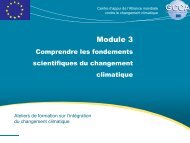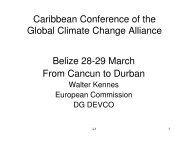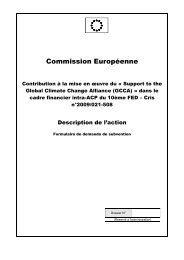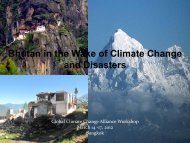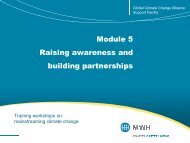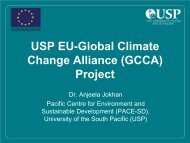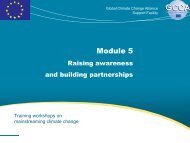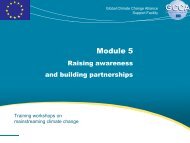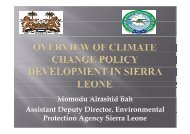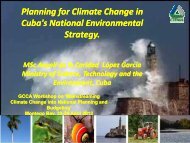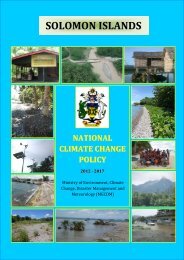Rwanda Green Growth Strategy 18nov11 - Global Climate Change ...
Rwanda Green Growth Strategy 18nov11 - Global Climate Change ...
Rwanda Green Growth Strategy 18nov11 - Global Climate Change ...
Create successful ePaper yourself
Turn your PDF publications into a flip-book with our unique Google optimized e-Paper software.
Chapter 3Vision and ObjectivesChapter 3: Vision and ObjectivesChapter 2 illustrated <strong>Rwanda</strong>’s potential to embark on a climate resilient low carbon developmentpathway. This chapter lays out a framework to make it happen. <strong>Climate</strong> change will fundamentally affecteconomic development and therefore a long-term vision is required. A vision for 2050 is given along withstrategic objectives that together achieve the vision. These objectives are guided by principles already laidout in Vision 2020 and EDPRS. Specific actions are required and 14 Programmes of Action for transformingkey sectors of the economy are the core of the <strong>Strategy</strong>. Enabling Pillars establish the processes andenabling environment required to mobilise the <strong>Strategy</strong>. Implementation is the crucial next step and aroadmap is given to guide implementation over the next five years, recognising that the <strong>Strategy</strong> is a firststep in a continuous process. These core components form the Strategic Framework illustrated in Figure12.3.1 A Vision for 2050Vision 2020 is a visionary document that has guided <strong>Rwanda</strong>’s development over the last decadeand contributed to its impressive economic growth and stability. Its goal for <strong>Rwanda</strong> to be a middle-incomecountry and knowledge based economy by 2020 will reduce vulnerability to climate change and contributeto climate resilience. Although not required to act, <strong>Rwanda</strong> has already shown its leadership on climatechange issues as part of the <strong>Climate</strong> Vulnerable Forum and the Cartagena Dialogue group. A Vision for2050 addresses the challenge of climate change and reiterates <strong>Rwanda</strong>’s plan to embrace best practices inthis realm. It recognises that in 2050, average temperatures will be higher, impacting on crop yields, healthand water resources while rainfall patterns may change, impacting on agriculture, power generation,infrastructure, biodiversity and ecosystem services. The global energy supply and demand and internationalenergy regulations may also be very different, reducing dependence on fossil fuels and associated GHGemissions. <strong>Rwanda</strong> seeks to be proactive and embark on a development path that is resilient andsustainable over the long term.Vision 2050: For <strong>Rwanda</strong> to be a developed climate-resilient, lowcarboneconomy by 2050.National <strong>Strategy</strong> on <strong>Climate</strong> <strong>Change</strong> and Low Carbon Development 17




